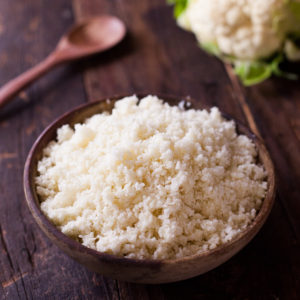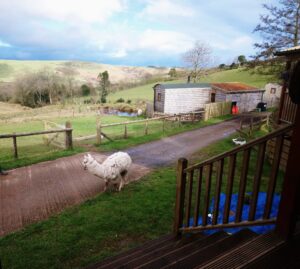
Cauliflower: health benefits, preparation & recipes
Cauliflower (cruciferous vegetable in the same group as Brussel sprouts and kale) is one of my favourite vegetables, especially in Autumn/winter months. When I was a child, I was only eating cauliflower in soups or as deep-fried.
But in recent years I have prepared it in various ways and with my son we really enjoy it. I hope this article will inspire you enough to give this sturdy brassica a try.
Check out how nutritious cauliflower really is:
Cauliflower is considered a superfood because of its nutrient-rich content. Cauliflower is naturally high in fibre and vitamins C, B and K and minerals such as magnesium, potassium, manganese, phosphorus and other important nutrients.
Cauliflower has a group of substances known as glucosinolates. As you chew and digest it, these substances are broken down into compounds that may help prevent cancer, they help protect cells from damage and have anti-inflammatory, antiviral, and antibacterial effects.
- Helps Reduce Cancer Risk
- Fights Inflammation
- Provides High Levels of Vitamins and Minerals (Especially Vitamin C and Vitamin K)
- Aids in Weight Loss
- Preserves Eye Health
- Helps Balance Hormones
- Improves Digestion and Detoxification
- Decreases Risk for Heart Disease and Brain Disorders
Caution: High-fibre foods like cauliflower may cause bloating and gas, especially for people with conditions such as irritable bowel syndrome (IBS), inflammatory bowel disease (IBD), Crohn’s disease, or ulcerative colitis.
How to store cauliflower:
Store your cauliflower in the fridge with the leaves on until cooking. As for all foods, it is best to eat it within a couple of days after purchase, although it will be fine for up to a week.
How to prepare it:
If the leaves are fresh, especially those near the core are sweet, cook them as well. The outer leaves may need to be discarded. The stalk can be used in most dishes – cut into slices and cook with the rest of the florets.
Cauliflower is versatile and can be prepared in several ways:
Raw – It is delicious on its own, in salads or as a cauliflower couscous.
Cauliflower Couscous (raw or roasted)
 Pulsing the curds in a processor until you have what resembles couscous (don’t over-process it or you will end up with a paste). You can also grate it instead for a chunkier texture. You can leave it raw or roast it lightly by thinly spreading it out on a baking tray in a hot oven for about 10 mins, until lightly toasted. You can add some spices like cumin, coriander, garam masala, chilli, ginger and garlic.
Pulsing the curds in a processor until you have what resembles couscous (don’t over-process it or you will end up with a paste). You can also grate it instead for a chunkier texture. You can leave it raw or roast it lightly by thinly spreading it out on a baking tray in a hot oven for about 10 mins, until lightly toasted. You can add some spices like cumin, coriander, garam masala, chilli, ginger and garlic.
This goes well with curries but avoid lots of liquid so it will not become a soggy cauliflower. This dish makes a trendy alternative to pasta, rice or couscous. It is especially good for low-carb diets.
Steam it – The simplest way is to steam it, about 3-6 mins depending on the size of florets. You can steam the whole head or cut it into florets. Steam the whole cauliflower, about 10 mins, and then grate it into a rice-like texture.
Boil it – You can also boil it, but do not overcook it, it should have a nice bite. I personally don’t boil my vegetables; except in soups of course, as I prefer steaming instead.
Roast it – Cut the head of cauliflower into steaks or florets, spread them on a cooking sheet, drizzle with oil, and sprinkle with sea salt and pepper. Roast for 10 mins in the oven or until just starting to brown at the edges.
Puree it – Once cauliflower has been steamed, it can be pureed until it’s smooth. Some people use it as a substitute for cream sauces.
Mash it – Boost the nutrition value of mashed potatoes by steaming some cauliflower and mashing it into them. Or skip the potatoes and opt for low-carb mashed cauliflower instead. Just add some plant-based milk, season well and serve. You also can mash cauliflower into pizza dough for a lighter crust.
Cauliflower works well with spices such as cumin, turmeric and coriander. Also, with mustard, vinegar, citrus, chillies, olives, nuts especially hazelnuts and pine nuts.
Below are 3 recipes from my book called Plant-Based Recipes for Healthy Living available here https://lenkapagan.com/plant-based-recipes-healthy-living/:
Potato Cauliflower Dish
INGREDIENTS
2 tbsp vegetable oil (I use coconut oil)
1 onion, peeled and diced
2 garlic cloves, chopped
5cm piece of fresh ginger, grated
1⁄2 tsp ground turmeric
1⁄2 tsp ground cumin
1⁄2 tsp ground coriander
1⁄2 tsp curry powder
1⁄2 cauliflower, cut into small florets
1 tomato, diced
1⁄2 lemon, juice
4-6 medium potatoes, peeled and chopped
1 handful of fresh coriander leaves
1 handful of frozen peas
Sea salt
Naan bread or brown rice to serve
PREPARATION:
- Heat the oil in a large saucepan, add onion and fry for a few minutes.
- Add all spices and keep stirring for a few minutes.
- Then add cauliflower, tomato, a splash of water and lemon juice. Cover and cook on a low heat until the cauliflower is tender (about 10 minutes). Keep checking and stirring occasionally so it will not burn. Add a bit of water if needed.
- In a separate pot boil or steam potatoes until just tender. Drain and set aside.
- When the cauliflower is almost tender, add peas, the potatoes, sea salt and cook for a couple of minutes.
- Serve with brown rice or naan bread and sprinkle with fresh coriander leaves.
Roasted Cauliflower with Lemon & Cumin
INGREDIENTS:
1 cauliflower, small pieces
1 lemon, juice
2 tbsp oil (I used coconut oil)
2 tsp cumin seeds
2 cloves of garlic, chopped
1 handful of roughly chopped coriander or parsley leaves
Sea salt and cayenne pepper for seasoning
Optional: 1-2 parsnips
PREPARATION:
- Heat the oven to 180 ̊C. Season the cauliflower with sea salt and spread it out with coconut oil (melted or solid) in an oven dish/roasting pan. Let it roast for about 12 minutes until lightly golden.
- Now turn the oven off, stir in the cumin seeds and lemon juice, close the oven and leave it in for further 3-5 minutes until tender.
- Remove the oven dish from the oven and serve with cooked buckwheat (pictured), rice or potatoes and sprinkle with chopped coriander, parsley or spinach leaves.
Brown Rice with Cauliflower & Carrots
INGREDIENTS
1 cauliflower
1 carrot
1-2 tbsp coconut oil
3 tbsp wholegrain oats
Brown rice
A few tablespoons of water or rice/oat milk
Sea salt
Turmeric
Nutmeg
Fresh parsley
PREPARATION
- Cook brown rice according to the instructions on the package.
- Wash cauliflower and cut into florets. Put them on melted coconut oil into a frying pan and stir fry for a few minutes.
- Add a few tablespoons of water or milk of your choice, grated carrot, oats, sea salt, turmeric and ground nutmeg.
- Stir frequently so it will not burn and until the cauliflower is tender (about 5-10 minutes).
Serve with brown rice and sprinkle with fresh parsley.
Enjoy! 🙂
Resources:
Plant-Based Recipes for Healthy Living by Lenka Pagan available here https://lenkapagan.com/plant-based-recipes-healthy-living
Autumn and Winter Veg by Guy Watson
www.draxe.com
 Previous Post
Previous Post Next Post
Next Post


